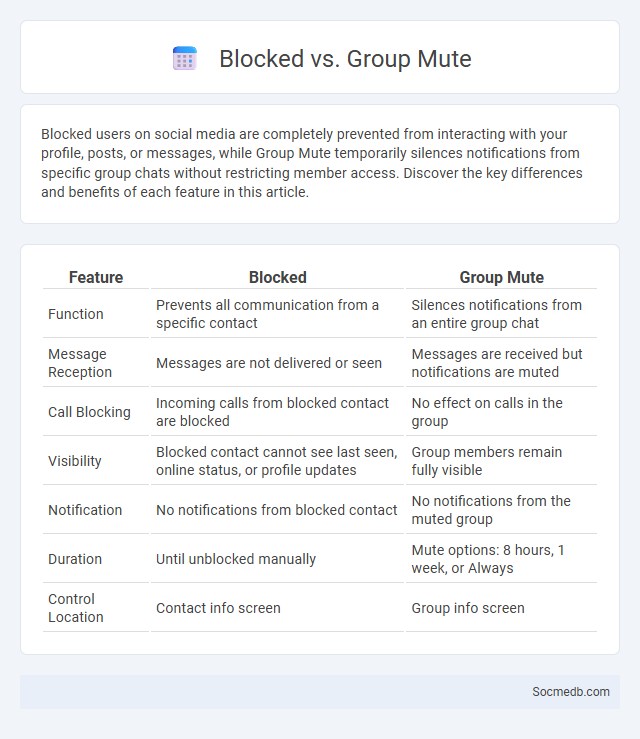
Photo illustration: Blocked vs Group Mute
Blocked users on social media are completely prevented from interacting with your profile, posts, or messages, while Group Mute temporarily silences notifications from specific group chats without restricting member access. Discover the key differences and benefits of each feature in this article.
Table of Comparison
| Feature | Blocked | Group Mute |
|---|---|---|
| Function | Prevents all communication from a specific contact | Silences notifications from an entire group chat |
| Message Reception | Messages are not delivered or seen | Messages are received but notifications are muted |
| Call Blocking | Incoming calls from blocked contact are blocked | No effect on calls in the group |
| Visibility | Blocked contact cannot see last seen, online status, or profile updates | Group members remain fully visible |
| Notification | No notifications from blocked contact | No notifications from the muted group |
| Duration | Until unblocked manually | Mute options: 8 hours, 1 week, or Always |
| Control Location | Contact info screen | Group info screen |
Understanding Blocked, Group Mute, and Blocked Contacts
Blocked contacts on social media platforms prevent unwanted users from viewing your profile, messaging you, or interacting with your content, ensuring enhanced privacy and control. Group mute allows users to silence notifications from specific group chats without leaving the group, maintaining engagement while reducing distractions. Understanding these features empowers users to manage their online interactions effectively, creating a safer and more tailored social media experience.
What Happens When You Block Someone?
When you block someone on social media, they lose the ability to see your profile, posts, stories, and send you messages or friend requests. Your content becomes invisible to them, and they cannot interact with you in any way on that platform. You maintain control over your online privacy and interactions by restricting unwanted communication effectively.
Features and Functionality of Group Mute
Group Mute allows users to temporarily silence notifications from a specific social media group, enhancing focus and reducing distractions. This feature enables customization of mute duration, from several hours to indefinitely, ensuring you control your engagement level without leaving the group. By managing notifications, Group Mute supports better productivity and mental well-being in fast-paced social media environments.
Blocked Contacts: How They Differ from Blocked Individuals
Blocked contacts in social media platforms refer to individuals saved in a user's contact list who are restricted from viewing or interacting with the user's profile, while blocked individuals can include anyone beyond contacts, such as strangers or followers. Blocking contacts often affects communication within personal networks, limiting calls, messages, or status updates from those specific entries, whereas blocked individuals encompass broader restrictions that prevent any form of engagement across the platform. Understanding the distinction helps users manage privacy settings more effectively by controlling interactions within their trusted circle versus the wider social media audience.
Communication Restrictions: Blocked vs. Group Mute
Communication restrictions on social media platforms vary between blocking and group muting, each serving distinct purposes for managing interactions. Blocking completely cuts off contact, preventing the blocked user from viewing your profile or sending messages, ensuring your privacy and safety. Group muting allows you to silence notifications or messages from specific members within a group chat without removing them, helping you maintain group dynamics while controlling your communication environment.
Privacy Implications of Blocking and Muting
Blocking and muting on social media significantly impact your privacy by controlling who can interact with you and view your content, effectively reducing unwanted exposure. These features help manage digital boundaries, preventing harassment and limiting the spread of personal information to certain users. Understanding the privacy implications of blocking and muting ensures you maintain control over your online presence and protect your personal data.
Notifications: What Blocked and Muted Contacts See
Blocked contacts on social media cannot see your notifications, posts, or updates, effectively cutting off all visible interactions. Muted contacts remain connected but do not receive alerts or notifications about your activity, maintaining a low-profile presence in your digital space. You control the visibility and notification settings, ensuring your privacy and reducing unwanted digital interruptions.
Managing Group Chats: Mute versus Blocking Participants
Managing group chats effectively requires understanding the difference between muting and blocking participants. Muting allows you to silence notifications from specific members without removing them, maintaining group cohesion while minimizing distractions. Blocking participants prevents them from sending messages altogether, which can be necessary to maintain a safe and respectful conversation environment.
When to Use Block, Mute, or Blocked Contacts
Using block on social media is essential when preventing harassment, spam, or unwanted interactions from specific accounts, ensuring complete restriction of contact and content visibility. Muting is ideal for reducing noise from friends or acquaintances without severing connections, allowing posts and messages to be hidden discreetly from your feed. Managing blocked contacts helps maintain a safe online environment by fully controlling who can view your profile and engage with your content, preserving personal boundaries.
Choosing the Right Option for Your Privacy Needs
Selecting the appropriate social media platform depends on evaluating each site's privacy features, such as data encryption levels, user control over personal information, and ad targeting policies. Platforms like Signal and Telegram emphasize strong privacy protections, while Facebook and Instagram have more extensive data sharing practices. Prioritizing options with transparent privacy settings and customizable sharing controls ensures better protection of your personal data online.
 socmedb.com
socmedb.com